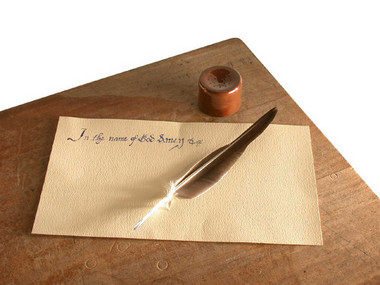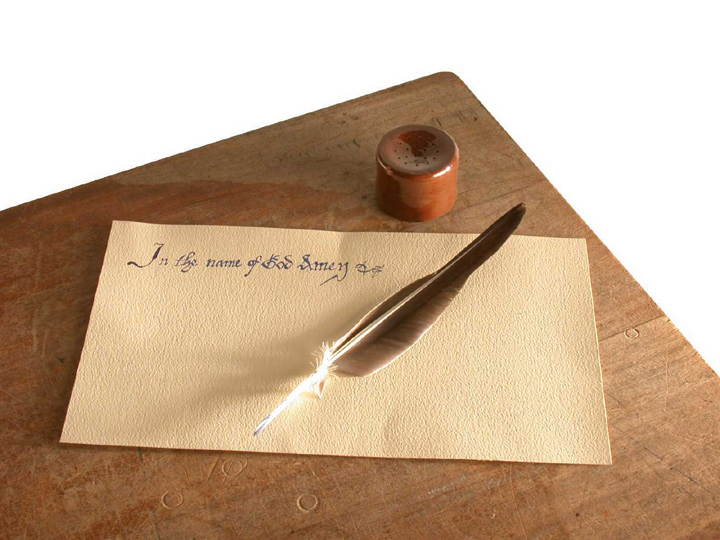Sand Shaker & Quill Pen, Tudor, Replica
A delete button, spell check and selection of fonts welcome many of us every day as we sit in front of the computer. When we do put pen to paper, our roller ball pen provides a controlled, instantly dry flow of ink, and a bottle of correction fluid can quickly wipe out an error.
The Tudors had different tools. A quill pen dipped in a bottle of ink provided the means to write on handmade papers or parchments of a variety of textures. But errors were inevitable, so how did the Tudors deal with a large black wet inky mistake soaking its way into a thick layer of paper? Quick removal of the ink was essential, and before the invention of blotting paper, sand was the fastest soaking medium to use.
Sprinkling clean sand onto the text soaked up the ink. The inky sand could be flicked away from the paper, and any residual stain removed by gently scraping it off with a knife.
This sand shaker is hand-thrown and glazed clay. Small enough to be held in one hand, the top of the shaker is pierced with small holes to allow sand to be shaken out. A larger opening on the base of the shaker enabled it to be filled. The top of the shaker is indented to prevent loose sand spreading onto the table.
The Tudors had different tools. A quill pen dipped in a bottle of ink provided the means to write on handmade papers or parchments of a variety of textures. But errors were inevitable, so how did the Tudors deal with a large black wet inky mistake soaking its way into a thick layer of paper? Quick removal of the ink was essential, and before the invention of blotting paper, sand was the fastest soaking medium to use.
Sprinkling clean sand onto the text soaked up the ink. The inky sand could be flicked away from the paper, and any residual stain removed by gently scraping it off with a knife.
This sand shaker is hand-thrown and glazed clay. Small enough to be held in one hand, the top of the shaker is pierced with small holes to allow sand to be shaken out. A larger opening on the base of the shaker enabled it to be filled. The top of the shaker is indented to prevent loose sand spreading onto the table.

Shaker: Height:5cm Quill: Length:33cm

Shaker: Height:5cm Quill: Length:33cm

A delete button, spell check and selection of fonts welcome many of us every day as we sit in front of the computer. When we do put pen to paper, our roller ball pen provides a controlled, instantly dry flow of ink, and a bottle of correction fluid can quickly wipe out an error.
The Tudors had different tools. A quill pen dipped in a bottle of ink provided the means to write on handmade papers or parchments of a variety of textures. But errors were inevitable, so how did the Tudors deal with a large black wet inky mistake soaking its way into a thick layer of paper? Quick removal of the ink was essential, and before the invention of blotting paper, sand was the fastest soaking medium to use.
Sprinkling clean sand onto the text soaked up the ink. The inky sand could be flicked away from the paper, and any residual stain removed by gently scraping it off with a knife.
This sand shaker is hand-thrown and glazed clay. Small enough to be held in one hand, the top of the shaker is pierced with small holes to allow sand to be shaken out. A larger opening on the base of the shaker enabled it to be filled. The top of the shaker is indented to prevent loose sand spreading onto the table.
The Tudors had different tools. A quill pen dipped in a bottle of ink provided the means to write on handmade papers or parchments of a variety of textures. But errors were inevitable, so how did the Tudors deal with a large black wet inky mistake soaking its way into a thick layer of paper? Quick removal of the ink was essential, and before the invention of blotting paper, sand was the fastest soaking medium to use.
Sprinkling clean sand onto the text soaked up the ink. The inky sand could be flicked away from the paper, and any residual stain removed by gently scraping it off with a knife.
This sand shaker is hand-thrown and glazed clay. Small enough to be held in one hand, the top of the shaker is pierced with small holes to allow sand to be shaken out. A larger opening on the base of the shaker enabled it to be filled. The top of the shaker is indented to prevent loose sand spreading onto the table.




















